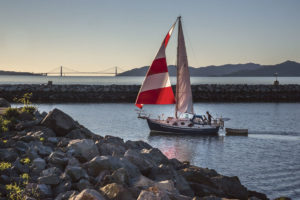In December 2010, Kay Kerr died at 99 years old. Kerr, along with Sylvia McLaughlin and Esther Gulick, founded the Save San Francisco Bay Association. They started by getting a legislative moratorium on a bay-fill project in Berkeley, but their work didn’t stop there. They went on to advocate for the creation of the Bay Conservation and Development Commission and the Don Edwards San Francisco Bay National Wildlife Refuge. Kerr’s passing comes just as Save the Bay marks its 50th year. The work of protecting and restoring the San Francisco Bay and its environs now seems to be in capable hands–thousands of them.
A decade ago, scientists and policymakers set the goal of 100,000 acres of intact tidal marshes around the Bay. Today, there are 44,000 acres of existing wetlands, with another 32,000 being restored. Save the Bay deploys 5,000 volunteers a year to help with the restoration. At Ravenswood Pond, part of the South Bay Salt Pond Restoration Project, staff and volunteers have removed 1,000 pounds of trash and 2,500 pounds of invasive weeds since 2008. To pitch in or learn more about Ravenswood, go to savesfbay.org/ravenswood.
Volunteers are also vital to the work of the San Francisco Bay Bird Observatory (SFBBO), which is celebrating its own anniversary this year. Thirty years ago, in 1981, SFBBO began monitoring nesting waterbirds, and a year later it started banding birds at the Coyote Creek Field Station. Today, staff and volunteers continue to arrive at the field station before dawn three times a week to unfurl the mist nets. The trained volunteers take the birds to a trailer where they weigh, measure, sex, and age them. “I like the immediate satisfaction of seeing birds up close,” says Gerry Ellis of San Jose, who has been volunteering for 19 years. “But in the bigger picture, we’re adding data year after year that allows biologists to understand the long-term trends of bird migration, population, and health.” Joyce Bartlett of Cupertino, who has been at it for 16 years, says she doesn’t like getting up at 4 a.m. but does like being part of an ongoing project that helps wildlife. In addition to helping researchers understand bird migration, dispersal, life span, and longevity, SFBBO’s program has helped document many species’ preference for restored habitats. To learn more about bird banding, attend a demonstration on Earth Day, April 23, 2011, or visit sfbbo.org.

.jpg)



